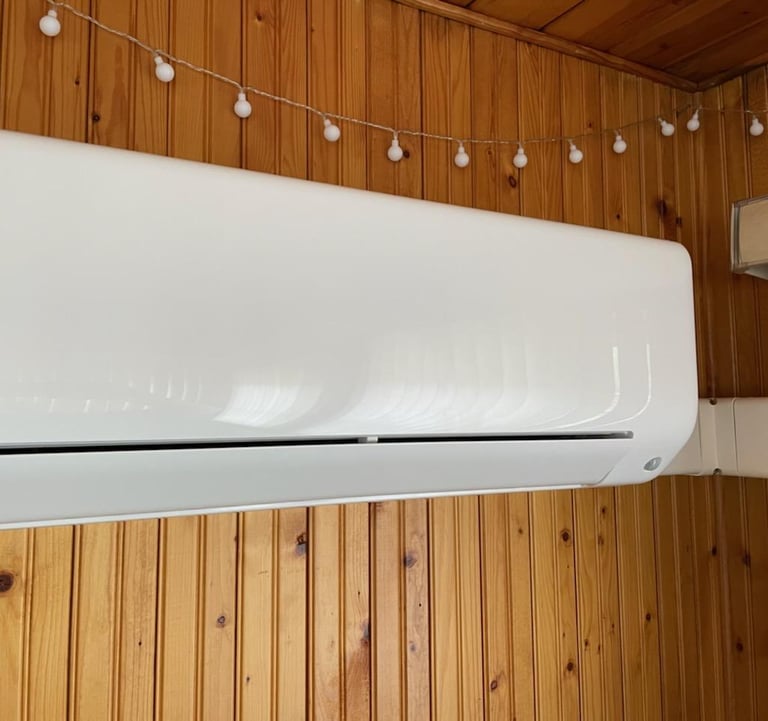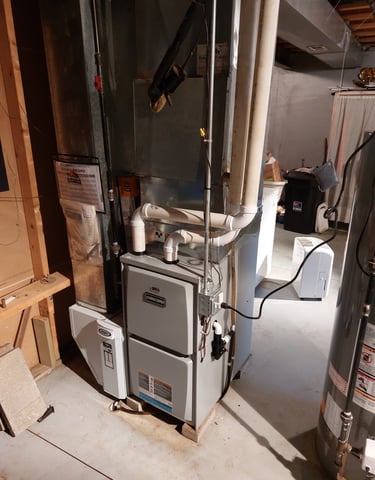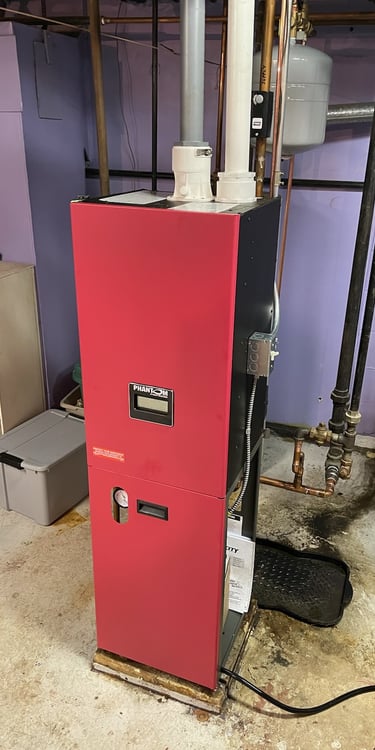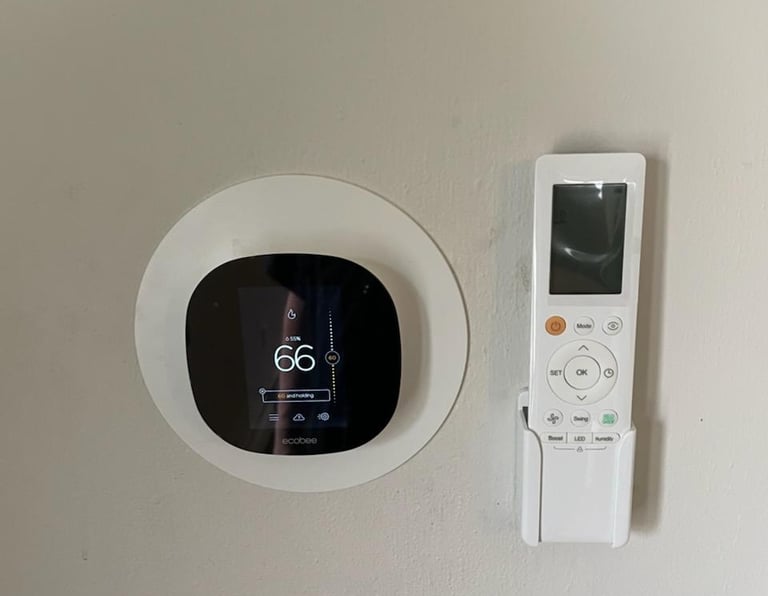Energy Efficient Heating & Cooling


Most of the energy used in your home is spent heating and cooling to make the building more comfortable. But did you know there are important ways you can reduce the energy use of your system and make it more comfortable at the same time? Here are a few efficiency measures to consider.
JoAnn from Milwaukee replaced a gas heating system with a ductless "mini-split" heat pump to heat and cool her 2nd floor, after first air sealing and insulating


An "air-source heat pump" may look like a large central-air conditioner, but this system can do so much more!
Heat Pumps Help Reduce Energy Bills
The space heating method of the 21st century, heat pumps work by moving heat through compressed refrigerant, not by burning fuels. While your furnace might be 92% efficient, a heat pump can be 200-300% efficient! (Every dollar of energy spent creating $2-$3 worth of energy costs.) Aside from being cost-effective, they are super-efficient air conditioners.
Heat pumps come in many forms. "Air source heat pumps" replace your central air conditioner. "Mini-split heat pumps" heat and cool a single zone. Both run on electricity, which means they can be powered by solar panels. This means their environmental impact is both in your home and beyond.
Many people in Wisconsin keep their furnaces for temperatures below freezing and rely on the heat pump to heat and cool the home above that, known as "dual fuel" or "hybrid" heat pumps. Heat pumps create fewer carbon emissions than your furnace or boiler.
High-Efficiency Furnaces, Boilers & Air Conditioners


However, some may look a little different than you're used to! Ductless minisplit heat pump indoor unit.
The most common method of heating our homes in Wisconsin is with natural gas. However, in parts of the state other fossil fuels like propane and fuel oil are not uncommon, especially small-town areas. This means gas appliances: furnaces or boilers.
Furnaces and boilers are rated as a percent "AFUE" - Annual Fuel Utilization Efficiency - which tells you how energy efficient it is. An “80% furnace” means it can convert 80% of all gas burned into heat, with the remaining 20% usually being lost up the chimney as waste. (Of course, that rating is in perfect laboratory settings and doesn't factor in upkeep or distribution efficiency)
Furnaces and boilers can get up to 96%+ efficiency levels. They also come with other added benefits such as energy efficient ("ECM") fans and sealed combustion for increased carbon monoxide safety.
Air conditioners are measured in "SEER" - Seasonal Energy Efficiency Ratio. A SEER of 16+ is a high-efficient system, with many heat pumps achieving well over SEER 18.




Photo: high efficiency sealed combustion boiler (left) and furnace (right)
Photo: before and after of leaky ductwork in an unheated space wasting money
Photo: duct sealed with mastic
Sealing & Insulating Ducts & Boiler Pipes
But what if I have the best heating system available but my rooms are still too cold/hot? It could be your HVAC "distribution system", aka your metal ductwork (if a furnace) or pipes (if a boiler). Small improvements can help you save even more much more affordably than a new heating system.
Ducts Sealing
Metal ductwork, whether round or square, has two issues to address: duct leaks and heat transfer through the sheet metal. Duct leaks can be solved by Duct Sealing, a process usually involving covering the gaps and connection pieces between all the metal pieces with a material called mastic, or sometimes mastic tape. Duct sealing is important for a few reasons: leaks can blow heated or cooled air into areas that are effectively out of the house (such as an attic or garage) wasting money. It can also over pressure or under pressure certain rooms in your home, not just making them too hot or too cold, but pushing air out through the gaps and cracks (see "air sealing") out of the home also making you lose money. Plus it can cause the furnace fan to have to run harder to get the heated/cooled air to the rooms you want them to go to.
Duct insulation is the way to address heat transfer through sheet metal. furnaces can create hot air at 130 degrees or higher to ensure the air coming through your registers is at the ideal temperature. But if it runs through cold spaces we can lose that heat. If your ducts run through areas you don't intend to heat the same way as the rest of the house (such as attics, crawlspaces, garages and/or unheated basements) then duct insulation can help reduce heat loss and save money.
Boiler Pipes
Just like with ductwork, if your boiler pipes run through areas you don't intend to heat the same way as the rest of your home, insulating them can reduce heat loss and save energy.




Smart Thermostats
Smart HVAC controls can help in reducing how much we spend to heat and cool our homes. The most common of these are smart thermostats.
Smart thermostats work in many ways to save money. Some models can learn your behavior and/or sense whether you are home, making adjustments that save energy. Many can be controlled remotely from your phone, or even "geofence" your phone to adjust the temperature based on your proximity to home. They are getting smarter and smarter!
Pros
Can adjust temperature smartly to save energy.
Can be controlled remotely, and can integrate with other smart devices.
Rebates are available to reduce the cost, especially when installed by an HVAC technician
Cons
Only saves energy if set up correctly and features utilized
Harder to install on some systems
Generally requires WiFi connection


Picture: Ecobee brand smart thermostat next to a ductless minisplit heat pump control
ECM Furnace Fan Motors
Electronically Commutated Motors for furnace fans, the energy efficiency upgrade you've probably never heard of. You know your furnace is mostly responsible for your gas bill, but what about electric bills?
How often your air handler runs (both for your furnace and your air conditioner) can have a big impact on your electric bills. High efficiency ECM fans are far more efficient than their predecessors: permanent split capacitor (PSC) fans. ECM fans work be ramping up and down more intentionally, providing a more consistent temperature, whereas PSC motors are either fully on or fully off. ECM fans CAN be installed on existing air handlers to increase their energy efficiency!
Did you know?
All new furnaces installed as of 2019 are required to have ECM fans for energy savings, but most furnaces installed prior to that don't have them!


Zone Systems for Comfort Throughout the House
Have a large building that you don't want to heat the same amount all the time? Or does running the system make certain rooms too warm or too cold? A zoned HVAC system could help. Proper HVAC zoning has automated dampers that control where heated and cooled air is delivered within the building, and can allow you to control different rooms at different temperatures.
Pros
Good way to control temperatures in large buildings without having to get multiple heating systems
Can save energy by not heating/cooling the entire building to the same level
Cons
Fixing the issues in a room that is too hot or too cold might be cheaper and easier by insulating/air-sealing or by sealing/insulating ductwork or boiler pipes first
Things That Don't Work
In the near future we will dedicate space to things that don't work to save energy in the home for your heating/cooling bills.


